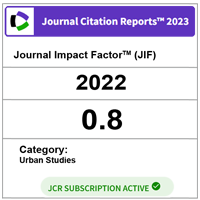The Effect Of Parenting Style On Adolescent’s Perception Towards Road Safety
DOI:
https://doi.org/10.11113/ijbes.v7.n1.414Keywords:
Parenting styles, Adolescent, Road SafetyAbstract
The purview of this paper is to analyze the relationships between parenting styles and adolescent risk behaviors on the road due to the critical parental role in preventing crashes among teens. The objectives of this research are to list different parenting styles that may influence adolescent behavior, to assess the relationship between parenting styles and adolescent’s perception towards road safety, to determine which parenting style that promotes a desirable street protection habits among adolescent, and to propose a framework that integrated parenting style to road safety program. Descriptive and statistical analyses are used in this paper to interpret the data taken from 298 questionnaire-respondents which the parallel between the desired parenting style and the adolescent’s good perception of road safety is cast using the Pearson Correlation Coefficient. A quantitative approach is employed in processing the data taken from those selected respondents then the qualitative data is composed and operated to complete the quantitative data by giving more comprehensive knowledge over the argumentation and more description of the quantitative result. More so, the study supports the substantial influence of parenting style on adolescent development such as the adolescents who are raised in authoritative households consistently demonstrate higher protective and fewer risk behaviors than adolescents from non-authoritative families.
References
Barnes, G. M., & Farrel, M. P. (1992). Parental Support and Control as Predictors of Adolescent Drinking, Delinquency, and Related Problem Behaviors. Journal of Marriage and Family, 54(4): 763 - 776.
Baumrind, D. (1991). Effective Parenting Style During The Early Adolescent Transition. In Family Transition, 111 - 164.
Berk, L. E. (2014). Development Through the Lifespan (Sixth ed.). Illinois: Pearson Education, Inc.
Borawski, E. A., Ievers-Landis, C. E., Lovegreen, L. D., & Trapl, E. S. (2003). Parental Monitoring, Negotiated Unsupervised Time, and Parental Trust: The Role of Perceived Parenting Practice in Adolescent Health Risk Behaviors. Journal of Adolescent Health, 33(2): 60 - 70.
Collins, C., Duncanson, K., & Burrows, T. (2014). A Systematic Review Investigating Associations Between Parenting Style and Child Feeding Behaviours. Journal of Human Nutrition and Dietetics. 27(6): 557 - 568.
Collins, D. C., & Kearns, R. A. (2005). Geographies of Inequality: Child Pedestrian Injury and Walking School Buses in Auckland, New Zealand. Social Science & Medicine. 60(1): 61 - 69.
Criss, M. M., Lee, T. K., Morris, A. S., Cui, L., Bosler, C. D., Shreffler, K. M., & Silk, J. S. (2015). Link Between Monitoring Behavior and Adolescent Adjustment: An Analysis of Direct and Indirect Effects. Journal of Child and Family Studies, 24(3): 668 - 678. doi:10.1007/s10826-013-9877-0.
Crosswhite, J. M., & Kerpelman, J. (2009). Coercion Theory, Self-Control, and Social Information Processing: Understanding Potential Mediators for How Parents Influence Deviant Behaviors. Deviant Behaviors, 30: 611 - 646.
Davis, J. D., Papandonatos, G. D., Miller, L. A., Hewitt, S. D., Festa, E. K., Heindel, W. C., et al. (2012). Road Test and Naturalistic Driving Performance in Healthy and Cognitively Impaired Older Adults: Does Environment Matter? of the American Geriatrics Society, 60(11): 2056 - 2062.
Dishion, T. J., & McMahon, R. J. (1998). Parental Monitoring and The Prevention of Child and Adolescent Problem Behavior: A Conceptual and Empirical Formulation. Clinical Child and Family Psychology Review. 1(1): 61 - 75.
Dishion, T. J., & Patterson, G. R. (2015). The Development and Ecology of Antisocial Behavior in Children and Adolescents. Developmental Psychopathology. 503 - 541. doi:10.1002/9780470939406.ch13
Donovan, J. E. (1993, September). Young Adult Drinking - Driving: Behavioral and Psychosocial Correlates. Journal of Studies on Alcohol. 600 - 613.
Fabiano, G. A., Schatz, N. K., Morris, K. L., Willoughby, M. T., Vujnovic, R. K., Hulme, K. F., Pelham, W. E. (2016). Efficacy of a Family-Focused Intervention For Young Drivers With Attention-Deficit Hyperactivity Disorder. Journal of Consulting and Clinical Psychology. 84(12): 1078–1093. doi:10.1037/ccp0000137
Hair, J. F., Black, W. C., Babin, B. J., & Anderson, R. E. (2009). Multivariate Data Analysis (Seventh ed.). New Jersey: Prentice Hall.
Hartos, J. L., Eitel, P., Haynie, D. L., & Simons-Morton, B. G. (2000, May). Can I Take the Car? Relations among Parenting Practices and Adolescent Problem - Driving Practices. Journal of Adolescent Research. 15(3): 352 - 367.
Hotz, G., Kennedy, A., Lutfi, K., & Cohn, S. M. (2009). Preventing Pediatric Pedestrian Injuries. The Journal of Trauma-Injury, Infection, and Critical Care. 66(5): 1492 - 1499.
Jessor, R. (1987). Problem - Behavior Theory, Psychosocial Development, and Adolescent Problem Drinking. British Journal of Addiction. 82: 331 - 342.
Keijsers, L. (2015). Parental Monitoring And Adolescent Problem Behaviors. International Journal of Behavioral Development, 40(3): 271–281. doi:10.1177/0165025415592515
Lajunen, T., Hakkarainen, P., & Summala, H. (1996). The Ergonomics of Road Signs: Explicit and Embedded Speed Limits. Ergonomics. 39(8): 1069 - 1083.
Laird, R. D., Criss, M. M., Pettit, G. S., Dodge, K. A., & Bates, J. E. (2008). Parents' Monitoring Knowledge Attenuates the Link Between Antisocial Friends and Adolescent Delinquent Behavior Journal of Abnormal Child Psychology, 36(3): 299 - 310. doi:10.1007/s10802-007-9178-4.
Lee, C.-T., Padilla-Walker, L. M., & Memmott-Elison, M. K. (2016). The Role Of Parents And Peers On Adolescents’ Prosocial Behavior And Substance Use. Journal of Social and Personal Relationships, 34(7): 1053–1069. doi:10.1177/0265407516665928
Longmore, M. A., Manning, W. D., & Giordano, P. C. (2001). Preadolescent Parenting Strategies and Teens' Dating and Sexual Initiation: A Longitudinal Analysis. Journal of Marriage and Family. 63(2): 322 - 335.
Mabbe, E., Soenens, B., Vansteenkiste, M., & Van Leeuwen, K. (2015). Do Personality Traits Moderate Relations Between Psychologically Controlling Parenting and Problem Behavior in Adolescents? Journal of Personality, 84(3), 381–392. doi:10.1111/jopy.12166
Maccoby, E. E., & Martin, J. A. (1983). Socialization in The Context of The Family: Parent-Child Interaction. In Handbook of Child Psychology. 4: 1 - 103.
Patterson, G. R., Dishion, T. J., & Chamberlain, P. (1993). Outcomes and Methodological Issues Relating to Treatment of Antisocial Children. In T. Giles (Ed.), Plenum Behavior Therapy Series. Handbook of Effective Psychotherapy. 43 - 88. New York: Plenum Press.
Pinquart, M. (2017). Associations of Parenting Dimensions And Styles With Externalizing Problems Of Children And Adolescents: An Updated Meta-Analysis. Developmental Psychology. 53(5): 873–932. doi:10.1037/dev0000295
Roscoe, P. B. (1995, September). The Perils of 'Positivism' in Cultural Anthropology. American Anthropologist, 97: 492 - 504.
Rumar, K. (1985). The Role of Perceptual and Cognitive Filters in Observed Behavior. In R. C. Schwing, & L. E., Human Behavior and Traffic Safety. 151 - 170. Boston: Springer.
Salkind, N. J. (2012). Exploring Research (Eight ed.). Upper Saddle River, New Jersey: Pearson Education, Inc.
Simons - Morton, B., & Ouimet, M. C. (2006, June). Parent Involvement in Novice Teen Driving: a Review of the Literature. Injury Prevention. 12: i30 - i37.
Simons, L.G., Sutton, T.E., Simons, R.L. et al. (2016). Journal of Youth and Adolescence, 45: 255. https://doi.org/10.1007/s10964-015-0409-7
Stattin, H., & Kerr, M. (2000). Parental Monitoring: A Reinterpretation. Child Development, 71(4): 1072 - 1085. doi:10.1111/1467-8624.00210
Twisk, D., Bos, N., Shope, J. T., & Kok, G. (2013). Changing Mobility Patterns and Road Mortality among Pre-License Teens in a Late Licensing Country: An Epidemiological Study. BMC Public Health, 13(333): 1 - 7. doi:10.1186/1471-2458-13-333
WHO. (2015). Global Status Report on Road Safety 2015. Retrieved March 11, 2018, from Violence Injury Prevention: http://www.who.int/violence_injury_prevention/road_safety_status/2015/en
Zare, F., Bakhshipour, B., & Hassanzadeh, R. (2014). Parenting Style and Mental Health in Iranian Adolescents. Journal of Novel Applied Sciences. 3(3): 274 - 277.
Zikmund, W., Babin, B. J., Carr, J. C., & Griffin, M. (2009). Business Research Methods (Eight ed.). South-Western College Pub.
Downloads
Published
How to Cite
Issue
Section
License
Copyright of articles that appear in International Journal of Built Environment and Sustainability belongs exclusively to Penerbit Universiti Teknologi Malaysia (Penerbit UTM Press). This copyright covers the rights to reproduce the article, including reprints, electronic reproductions or any other reproductions of similar nature.
Authors who publish with this journal agree to the following terms:
- This Journal applies Creative Commons Licenses of CC-BY-NC-SA
- Authors retain copyright and grant the journal right of publication with the work simultaneously licensed under a Creative Commons Attribution License that allows others to share the work with an acknowledgement of the work's authorship and publication in this journal.
- Authors are able to enter into separate, additional contractual arrangements for the non-exclusive distribution of the journal's published version of the work (e.g., post it to an institutional repository or publish it in a book), with an acknowledgement of its publication in this journal.
- Authors are permitted and encouraged to post their work online (e.g., in institutional repositories or on their website) prior to and during the submission process, as it can lead to productive exchanges, as well as earlier and greater citation of published work (See The Effect of Open Access).







